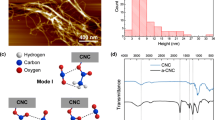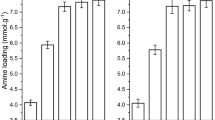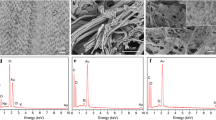Abstract
Climate change has become increasingly serious due to the greenhouse effect. It is therefore necessary to control the content of greenhouse gases such as carbon dioxide in the atmosphere, using, for instance, CO2-adsorbing materials. Here, we synthesized ultra-lightweight and spherical cellulose nanofibres aerogels by a suspension titration method using an efficient amination process. These functional materials with high porosity, higher than 96.54%, and three-dimensional network structure, were prepared by freeze-drying spherical cellulose nanofibres hydrogel. Their maximum CO2 adsorption capacity reaches 1.78 mmol/g, and they show excellent regeneration, of more than 10 cycles. This synthesis of bioaerogels represents a new method for the preparation of bio-CO2 adsorbents.


Similar content being viewed by others
References
Abdelmouleha M, Boufia S, Belgacemb MN, Duartec AP, Salaha AB, Gandinib A (2004) Modification of cellulosic fibres with functionalised silanes: development of surface properties. Int J Adhes Adhes 24:43–54. https://doi.org/10.1016/S0143-7496(03)00099-X
Aulin C, Varga I, Claesson PM, Wågberg L, Lindström T (2008) Buildup of polyelectrolyte multilayers of polyethyleneimine and microfibrillated cellulose studied by in situ dual-polarization interferometry and quartz crystal microbalance with dissipation. Langmuir ACS J Surf Colloids 24:2509–2518. https://doi.org/10.1021/la7032884
Bacsik Z, Ahlsten N, Ziadi A, Zhao G, Garciabennett AE, Martínmatute B, Hedin N (2011) Mechanisms and kinetics for sorption of CO2 on bicontinuous mesoporous silica modified with n-propylamine. Langmuir ACS J Surf Colloids 27:11118–11128. https://doi.org/10.1021/la202033p
Cai J, Kimura S, Wada M, Kuga S, Zhang L (2008) Cellulose aerogels from aqueous alkali hydroxide–urea solution. Chemsuschem 1(1–2):149. https://doi.org/10.1002/cssc.200700039
Cervin NT, Aulin C, Larsson PT, Wågberg L (2012) Ultra porous nanocellulose aerogels as separation medium for mixtures of oil/water liquids. Cellulose 19:401–410. https://doi.org/10.1007/s10570-011-9629-5
Chakraborty AK, Bischoff KB, Astarita G, Damewood JR (2002) Molecular orbital approach to substituent effects in amine–CO2 interactions. J Am Chem Soc 110:6947–6954. https://doi.org/10.1021/ja00229a003
Chen Z, Deng S, Wei H, Wang B, Huang J, Gang Y (2013) Polyethylenimine-impregnated resin for high CO2 adsorption: an efficient adsorbent for CO2 capture from simulated flue gas and ambient air. ACS Appl Mater Interfaces 5(15):6937–6945. https://doi.org/10.1021/am400661b
Chen W, Li Q, Wang Y, Yi X, Zeng J, Yu H, Liu Y, Li J (2014) Comparative study of aerogels obtained from differently prepared nanocellulose fibers. ChemSusChem 7(1):154–161. https://doi.org/10.1002/cssc.201300950
Chen SJ, Fu Y, Huang YX, Tao ZC, Zhu M (2016) Experimental investigation of CO2 separation by adsorption methods in natural gas purification. Appl Energy 179:329–337. https://doi.org/10.1016/j.apenergy.2016.06.146
Danon A, Stair PC, Weitz E (2016) FTIR study of CO2 adsorption on amine-grafted SBA-15: elucidation of adsorbed species. J Phys Chem C 115:11540–11549. https://doi.org/10.1021/jp200914v
Fischer F, Rigacci A, Pirard R, Berthon-Fabry S, Achard P (2006) Cellulose-based aerogels. Polymer 47:7636–7645. https://doi.org/10.1016/j.polymer.2006.09.004
Fu J, Wang S, He C, Lu Z, Huang J, Chen Z (2016) Facilitated fabrication of high strength silica aerogels using cellulose nanofibrils as scaffold. Carbohyd Polym 147:89–96. https://doi.org/10.1016/j.carbpol.2016.03.048
Ganster J, Fink HP (2003) Physical constants of cellulose. Wiley, New York. https://doi.org/10.1002/0471532053.bra036
Gavillon R, Budtova T (2008) Aerocellulose: new highly porous cellulose prepared from cellulose–NaOH aqueous solutions. Biomacromolecules 9(1):269–277. https://doi.org/10.1021/bm700972k
Gebald C, Wurzbacher JA, Tingaut P, Zimmermann T, Steinfeld A (2011) Amine-based nanofibrillated cellulose as adsorbent for CO2 capture from air. Environ Sci Technol 45:9101–9108. https://doi.org/10.1021/es202223p
Hiyoshi N, Yogo K, Yashima T (2005) Adsorption of carbon dioxide on aminosilane-modified mesoporous silica. J Jpn Pet Inst 48:29–36. https://doi.org/10.1627/jpi.48.29
Huang HJ, Yuan WK, Chen XD (2006) Microencapsulation based on emulsification for producing pharmaceutical products: a literature review. Asia Pac J Chem Eng 14:515–544. https://doi.org/10.1002/apj.5500140318
Jin H, Nishiyama Y, Wada M, Kuga S (2004) Nanofibrillar cellulose aerogels. Colloids Surf A 240:63–67. https://doi.org/10.1016/j.colsurfa.2004.03.007
Jin C, Han S, Li J, Sun Q (2015) Fabrication of cellulose-based aerogels from waste newspaper without any pretreatment and their use for absorbents. Carbohyd Polym 123:150–156. https://doi.org/10.1016/j.carbpol.2015.01.056
Kerr RA (2007) Climate change—scientists tell policymakers we’re all warming the world. Science 315:754–757. https://doi.org/10.1126/science.315.5813.754
Khatri RA, Chuang SSC, Soong Y, Gray M (2005) Carbon dioxide capture by diamine-grafted SBA-15: a combined fourier transform infrared and mass spectrometry study. Ind Eng Chem Res 44(10):3702–3708. https://doi.org/10.1021/ie048997s
Kim S, Ida J, Guliants V, Lin YS (2005) Tailoring surface properties of MCM-48 silica for selective adsorption of CO2. J Phys Chem B 109:6287–6293
Kim J, Rubino I, Lee JY, Choi HJ (2016) Application of halloysite nanotubes for carbon dioxide capture. Mater Res Express 3(4):045019. https://doi.org/10.1088/2053-1591/3/4/045019
Knöfel C, Martin C, Hornebecq V, Llewellyn PL (2009) Study of carbon dioxide adsorption on mesoporous aminopropylsilane-functionalized silica and titania combining microcalorimetry and in situ infrared spectroscopy. J Phys Chem C 113:21726–21734. https://doi.org/10.1021/jp907054h
Lais A, Gondal MA, Dastageer MA (2017) Semiconducting oxide photocatalysts for reduction of CO2 to methanol. Environ Chem Lett 2:1–28. https://doi.org/10.1007/s10311-017-0673-8
Liu FQ, Wang L, Huang ZG, Li CQ, Li W, Li RX, Li WH (2014) Amine-tethered adsorbents based on three-dimensional macroporous silica for CO(2) capture from simulated flue gas and air. ACS Appl Mater Interfaces 6(6):4371–4381. https://doi.org/10.1021/am500089g
Lu J, Askeland P, Drzal LT (2008) Surface modification of microfibrillated cellulose for epoxy composite applications. Polymer 49:1285–1296. https://doi.org/10.1016/j.polymer.2008.01.028
Lu W, Sculley JP, Yuan D, Krishna R, Zhou HC (2013) Carbon dioxide capture from air using amine-grafted porous polymer networks. J Phys Chem C 117:4057–4061. https://doi.org/10.1021/jp311512q
Mehmood K, Chang S, Yu S, Wang L, Li P, Li Z, Liu W, Rosenfeld D, Seinfeld JH (2017) Spatial and temporal distributions of air pollutant emissions from open crop straw and biomass burnings in China from 2002 to 2016. Environ Chem Lett. https://doi.org/10.1007/s10311-017-0675-6
Mohammed FS, Wuttigul S, Kitchens CL (2011) Dynamic surface properties of amino-terminated self-assembled monolayers incorporating reversible CO2 chemistry. Ind Eng Chem Res 50:8034–8041. https://doi.org/10.1021/ie102526s
Niu M, Yang H, Zhang X, Wang Y, Tang A (2016) Amine-impregnated mesoporous silica nanotube as an emerging nanocomposite for CO2 capture. ACS Appl Mater Interfaces 8(27):17312. https://doi.org/10.1021/acsami.6b05044
Plaza MG, Pevida C, Arenillas A, Rubiera F, Pis JJ (2007) CO2 capture by adsorption with nitrogen enriched carbons. Fuel 86:2204–2212. https://doi.org/10.1016/j.fuel.2007.06.001
Rochelle GT (2009) Amine scrubbing for CO2 capture. Science 325:1652–1654. http://www.jstor.org/stable/40301873
Roth EA, Agarwal S, Gupta RK (2013) Nanoclay-based solid sorbents for CO2 capture. Energy Fuels 27:4129–4136. https://doi.org/10.1021/ef302017m
Sehaqui H, Salajková M, Zhou Q, Berglund LA (2010) Mechanical performance tailoring of tough ultra-high porosity foams prepared from cellulose I nanofiber suspensions. Soft Matter 6:1824–1832. https://doi.org/10.1039/b927505c
Sehaqui H, Allais M, Zhou Q, Berglund LA (2011a) Wood cellulose biocomposites with fibrous structures at micro- and nanoscale. Compos Sci Technol 71:382–387. https://doi.org/10.1016/j.compscitech.2010.12.007
Sehaqui H, Zhou Q, Berglund LA (2011b) High-porosity aerogels of high specific surface area prepared from nanofibrillated cellulose (NFC). Compos Sci Technol 71:1593–1599. https://doi.org/10.1016/j.compscitech.2011.07.003
Sehaqui H, Becatinni V, Cheng NY, Steinfeld A, Zimmermann T, Tingaut P (2015) Fast and reversible direct CO2 capture from air onto all-polymer nanofibrillated cellulose—polyethyleneimine foams. Environ Sci Technol 49(5):3167. https://doi.org/10.1021/es504396v
Sharma P, Baek IH, Park YW, Nam SC, Park JH, Park SD, Park SY (2012) Adsorptive separation of carbon dioxide by polyethyleneimine modified adsorbents. Korean J Chem Eng 29:249–262. https://doi.org/10.1007/s11814-011-0158-6
Shi J, Lu L, Guo W, Zhang J, Cao Y (2013) Heat insulation performance, mechanics and hydrophobic modification of cellulose–SiO2 composite aerogels. Carbohyd Polym 98:282–289. https://doi.org/10.1016/j.carbpol.2013.05.082
Shlyakhtina AV, Oh YJ (2008) Transparent SiO2 aerogels prepared by ambient pressure drying with ternary azeotropes as components of pore fluid. J Non Cryst Solids 354:1633–1642. https://doi.org/10.1016/j.jnoncrysol.2007.10.033
Silva TCF, Habibi Y, Colodette JL, Elder T, Lucia LA (2012) A fundamental investigation of the microarchitecture and mechanical properties of tempo-oxidized nanofibrillated cellulose (NFC)-based aerogels. Cellulose 19:1945–1956. https://doi.org/10.1007/s10570-012-9761-x
Svagan AJ, Samir MASA, Berglund LA (2008) Biomimetic foams of high mechanical performance based on nanostructured cell walls reinforced by native cellulose nanofibrils. Adv Mater 20:1263–1269. https://doi.org/10.1002/adma.200701215
Víctor-Román S, Simón-Herrero C, Romero A, Gracia I, Valverde JL, Sánchez-Silva L (2015) CNF-reinforced polymer aerogels: influence of the synthesis variables and economic evaluation. Chem Eng J 262:691–701. https://doi.org/10.1016/j.cej.2014.10.026
Vilarrasa-Garcia E, Moya EMO, Cecilia JA Jr, Cavalcante CL, Jiménez-Jiménez J, Azevedo DCS, Rodríguez-Castellón E (2015) CO2 adsorption on amine modified mesoporous silicas: effect of the progressive disorder of the honeycomb arrangement. Microporous Mesoporous Mater 209:172–183. https://doi.org/10.1016/j.micromeso.2014.08.032
Xu X, Song C, Andrésen JM, Miller BG, Scaroni AW (2003) Preparation and characterization of novel CO2 “molecular basket” adsorbents based on polymer-modified mesoporous molecular sieve MCM-41. Microporous Mesoporous Mater 62:29–45. https://doi.org/10.1016/S1387-1811(03)00388-3
Zhang X, Zheng X, Zhang S, Zhao B, Wu W (2012) AM-TEPA impregnated disordered mesoporous silica as CO2 capture adsorbent for balanced adsorption–desorption properties. Ind Eng Chem Res 51:15163–15169. https://doi.org/10.1021/ie300180u
Zhang Z, Sèbe G, Rentsch D, Zimmermann T, Tingaut P (2014) Ultralightweight and flexible silylated nanocellulose sponges for the selective removal of oil from water. Geogr Res 26:2659–2668. https://doi.org/10.1021/cm5004164
Zhang Z, Wang H, Li S, Li L, Li D (2015) Transparent and flexible cellulose nanofibers/silver nanowires/acrylic resin composite electrode. Composites A 76:309–315. https://doi.org/10.1016/j.compositesa.2015.06.010
Zhang H, Liu R, Lal R (2016) Optimal sequestration of carbon dioxide and phosphorus in soils by gypsum amendment. Environ Chem Lett 14:443–448. https://doi.org/10.1007/s10311-016-0564-4
Zhao Y, Xu C, Xing C, Shi X, Matuana LM, Zhou H, Ma X (2015) Fabrication and characteristics of cellulose nanofibril films from coconut palm petiole prepared by different mechanical processing. Ind Crops Prod 65:96–101. https://doi.org/10.1016/j.indcrop.2014.11.057
Zheng Q, Cai Z, Gong S (2014) Green synthesis of polyvinyl alcohol (PVA)–cellulose nanofibril (CNF) hybrid aerogels and their use as superabsorbents. J Mater Chem A 2:3110–3118. https://doi.org/10.1039/c3ta14642a
Zheng Q, Zhang H, Mi H, Cai Z, Ma Z, Gong S (2016) High-performance flexible piezoelectric nanogenerators consisting of porous cellulose nanofibril (CNF)/poly(dimethylsiloxane) (PDMS) aerogel films. Nano Energy 26:504–512. https://doi.org/10.1016/j.nanoen.2016.06.009
Acknowledgements
This work was financially supported by the Special Fund for Forest Scientific Research in the Public Welfare (201504603), the Priority Academic Program Development (PAPD) of Jiangsu Higher Education Institutions, and the Doctorate Fellowship Foundation of Nanjing Forestry University of China (163020772).
Author information
Authors and Affiliations
Corresponding author
Rights and permissions
About this article
Cite this article
Liu, S., Zhang, Y., Jiang, H. et al. High CO2 adsorption by amino-modified bio-spherical cellulose nanofibres aerogels. Environ Chem Lett 16, 605–614 (2018). https://doi.org/10.1007/s10311-017-0701-8
Received:
Accepted:
Published:
Issue Date:
DOI: https://doi.org/10.1007/s10311-017-0701-8




